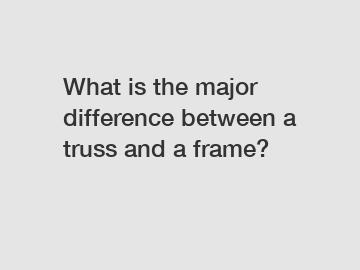What is the major difference between a truss and a frame?
What is the major difference between a truss and a frame?
Trusses and frames are structural systems commonly used in construction and engineering. While both serve the purpose of providing support and stability, there are key differences between the two. In this article, we will delve into the characteristics of trusses and frames, and explore their major distinctions.
Trusses:

1. Definition: A truss is a structural assembly made up of straight members connected at their ends by joint nodes. These members are typically arranged in triangular or pyramidal shapes.
2. Load Distribution: Trusses primarily rely on the distribution of loads along the members' axes, known as axial loads. This feature gives trusses excellent load-bearing capabilities, enabling them to efficiently transfer forces to the supports.
3. Force Transmission: Due to their triangular configuration, trusses can transmit loads through tension and compression forces along their members. This distribution of forces makes trusses incredibly stable.
4. Spanning Capability: Trusses are highly efficient for spanning long distances, making them ideal for structures such as bridges and roofs. The triangular arrangement of members ensures minimal bending and deformation, allowing trusses to support heavy loads with minimal sagging.
Frames:
1. Definition: Frames are structural systems composed of beams or columns connected together to form a rigid framework, often rectangular or square in shape.
2. Load Distribution: Unlike trusses, frames primarily rely on the distribution of loads through bending moments, which cause the structural elements to deflect. The deflection redistributes the loads, making frames resilient and resistant to failure.
3. Force Transmission: Frames transmit loads through bending moments, resulting in varying levels of bending stresses across their members. The horizontal beams and columns work together to support and distribute the loads, making frames highly adaptable.
4. Rigidity: Frames exhibit high structural rigidity due to the presence of fixed connections at their joints. This rigidity allows frames to resist deformation and provide stability, ensuring the integrity of the structure.
Now, let's draw a conclusion regarding the major difference between trusses and frames.
In summary, while both trusses and frames serve the purpose of providing structural support, their major difference lies in their load distribution and force transmission mechanisms. Trusses rely on axial loads transmitted through tension and compression along their straight members, allowing them to span long distances efficiently. On the other hand, frames distribute loads primarily through bending moments and rely on a combination of horizontal beams and columns for force transmission, offering greater adaptability and rigidity.
Are you interested in learning more about Coal Shed Space Frame Features, Steel Truss Price, stadium skylight? Contact us today to secure an expert consultation!

Comments